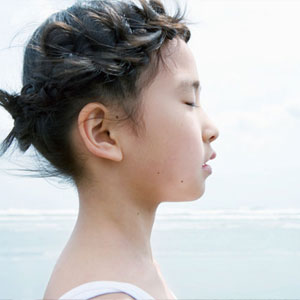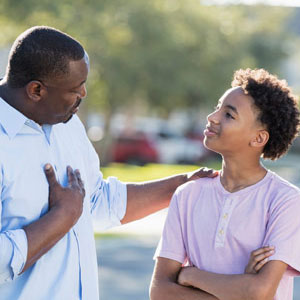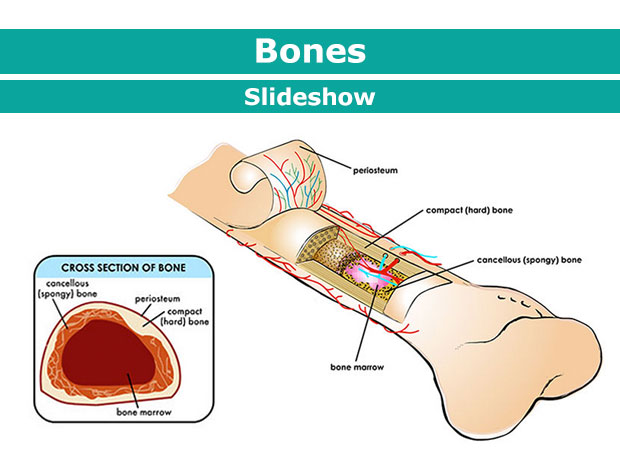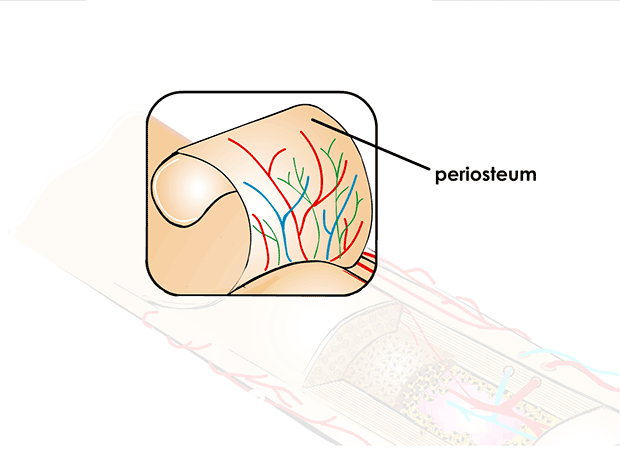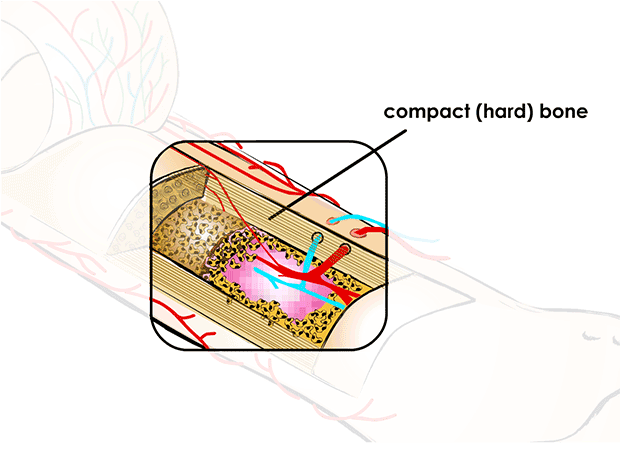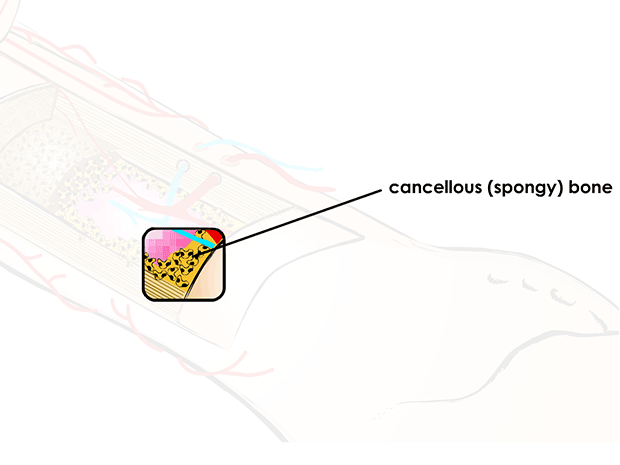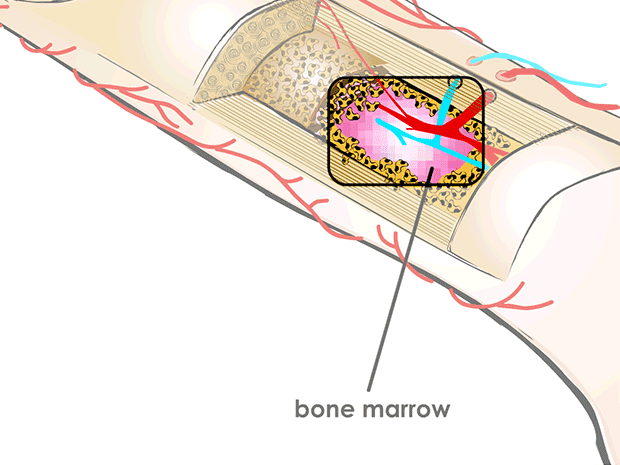Every single person has a skeleton made up of many bones. These bones give your body structure, let you move in many ways, protect your internal organs, and more.
It's time to look at all your bones — the adult human body has 206 of them!
What Are Bones Made Of?
If you've ever seen a real skeleton or fossil in a museum, you might think that all bones are dead. Although bones in museums are dry, hard, or crumbly, the bones in your body are different. The bones that make up your skeleton are all very much alive, growing and changing all the time like other parts of your body.
Almost every bone in your body is made of the same materials:
- The outer surface of bone is called the periosteum (say: pare-ee-OSS-tee-um). It's a thin, dense membrane that contains nerves and blood vessels that nourish the bone.
- The next layer is made up of compact bone. This part is smooth and very hard. It's the part you see when you look at a skeleton.
- Within the compact bone are many layers of cancellous (say: KAN-sell-us) bone, which looks a bit like a sponge. Cancellous bone is not quite as hard as compact bone, but it is still very strong.
- In many bones, the cancellous bone protects the innermost part of the bone, the bone marrow (say: MAIR-oh). Bone marrow is sort of like a thick jelly, and its job is to make blood cells.
P
How Do Bones Grow?
When you were a baby, you had tiny hands, tiny feet, and tiny everything! Slowly, as you grew older, everything became a bit bigger, including your bones.
A baby's body has about 300 bones at birth. These eventually fuse (grow together) to form the 206 bones that adults have. Some of a baby's bones are made entirely of a special material called cartilage (say: KAR-tel-ij). Other bones in a baby are partly made of cartilage. This cartilage is soft and flexible. During childhood, as you are growing, the cartilage grows and is slowly replaced by bone, with help from calcium.
By the time you are about 25, this process will be complete. After this happens, there can be no more growth — the bones are as big as they will ever be. All of these bones make up a skeleton that is both very strong and very light.
What Does the Spine Do?
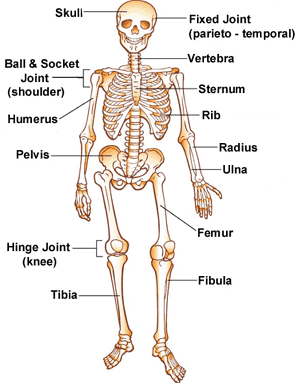
Your spine is one part of the skeleton that's easy to check out: Reach around to the center of your back and you'll feel its bumps under your fingers.
The spine lets you twist and bend, and it holds your body upright. It also protects the spinal cord, a large bundle of nerves that sends information from your brain to the rest of your body. The spine is special because it isn't made of one or even two bones: It's made of 33 bones in all! These bones are called vertebrae (say: VER-tuh-bray) and each one is shaped like a ring.
There are different types of vertebrae in the spine and each does a different kind of job:
- The first seven vertebrae at the top are called the cervical (say: SIR-vih-kul) vertebrae. These bones are in the back of your neck, just below your brain, and they support your head and neck. Your head is pretty heavy, so it's lucky to have help from the cervical vertebrae!
- Below the cervical vertebrae are the thoracic (say: thuh-RAS-ik) vertebrae, and there are 12 in all. These guys anchor your ribs in place. Below the thoracic vertebrae are five lumbar (say: LUM-bar) vertebrae. Beneath the lumbar vertebrae is the sacrum (say: SAY-krum), which is made up of five vertebrae that are fused together to form one single bone.
- Finally, all the way at the bottom of the spine is the coccyx (say: COK-siks), which is one bone made of four fused vertebrae. The bottom sections of the spine are important when it comes to bearing weight and giving you a good center of gravity. So when you pick up a heavy backpack, the lumbar vertebrae, sacrum, and coccyx give you the power. When you dance, skip, and even walk, these parts help keep you balanced.
In between each vertebra (the name for just one of the vertebrae) are small disks made of cartilage. These disks keep the vertebrae from rubbing against one another, and they also act as your spine's natural shock absorbers. When you jump in the air, or twist while slamming a dunk, the disks give your vertebrae the cushioning they need.
What Do the Ribs Do?
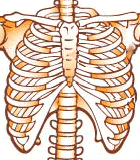
Your heart, lungs, and liver are all very important, and luckily you've got ribs to keep them safe. Ribs act like a cage of bones around your chest. It's easy to feel the bottom of this cage by running your fingers along the sides and front of your body, a few inches below your heart. If you breathe in deeply, you can easily feel your ribs right in the front of your body, too. Some thin kids can even see a few of their ribs right through their skin.
Your ribs come in pairs, and the left and right sides of each pair are exactly the same. Most people have 12 pairs of ribs, but some people are born with one or more extra ribs, and some people might have one pair less.
All 12 pairs of ribs attach in the back to the spine, where they are held in place by the thoracic vertebrae. The first seven pairs of ribs attach in the front to the sternum (say: STUR-num), a strong bone in the center of your chest that holds those ribs in place. The remaining sets of ribs don't attach to the sternum directly. The next three pairs are held on with cartilage to the ribs above them.
The very last two sets of ribs are called floating ribs because they aren't connected to the sternum or the ribs above them. But don't worry, these ribs can't ever float away. Like the rest of the ribs, they are securely attached to the spine in the back.
What Does the Skull Do?
Your skull protects the most important part of all, the brain. You can feel your skull by pushing on your head, especially in the back a few inches above your neck. The skull is actually made up of different bones. Some of these bones protect your brain, whereas others make up the structure of your face. If you touch beneath your eyes, you can feel the ridge of the bone that forms the hole where your eye sits.
And although you can't see it, the smallest bone in your whole body is in your head, too. The stirrup bone behind your eardrum is only .1 to .13 inches (2.5 to 3.3 millimeters) long! Want to know something else? Your lower jawbone is the only bone in your head you can move. It opens and closes to let you talk and chew food.
Your skull is pretty cool, but it's changed since you were a baby. All babies are born with spaces between the bones in their skulls. This allows the bones to move, close up, and even overlap as the baby goes through the birth canal. As the baby grows, the space between the bones slowly closes up and disappears, and special joints called sutures (say: SOO-churs) connect the bones.
What Do the Bones In the Arm Do?

As you sit and type at the keyboard, while you swing on a swing, even when you pick up your lunch, you're using the bones in your fingers, hand, wrist, and arm.
Each arm is attached to a shoulder blade or scapula (say: SKA-pyuh-luh), a large triangular bone on the upper back corner of each side of the ribcage. The arm is made up of three bones: the humerus (say: HYOO-muh-rus), which is above your elbow, and the radius (say: RAY-dee-us) and ulna (say: UL-nuh), which are below the elbow.
Each of these bones is wider at the ends and skinnier in the middle, to help give it strength where it meets another bone. At the end of the radius and ulna are eight smaller bones that make up your wrist. Although these bones are small, they can really move! Twist your wrist around or wave and you'll see how the wrist can move.
What Do the Bones in the Hand Do?
The center part of your hand is made up of five separate bones. Each finger on your hand has three bones, except for your thumb, which has two. So between your wrists, hands, and all your fingers, you've got a grand total of 54 bones — all ready to help you grasp things, write your name, pick up the phone, or throw a softball!
What Do the Leg Bones Do?
Sure, your arm, wrist, hand, and finger bones are great for picking up the phone, but how are you supposed to run to answer it? Well, with the bones of the legs and feet!
Your legs are attached to a circular group of bones called your pelvis. The pelvis is a bowl-shaped structure that supports the spine. It is made up of the two large hip bones in front, and behind are the sacrum and the coccyx. The pelvis acts as a tough ring of protection around parts of the digestive system, parts of the urinary system, and parts of the reproductive system.
Your leg bones are very large and strong to help support the weight of your body. The bone that goes from your pelvis to your knee is called the femur (say: FEE-mur), and it's the longest bone in your body. At the knee, there's a triangular-shaped bone called the patella (say: puh-TEL-luh), or kneecap, that protects the knee joint. Below the knee are two other leg bones: the tibia (say: TIH-bee-uh) and the fibula (say: FIH-byuh-luh). Just like the three bones in the arm, the three bones in the leg are wider at the ends than in the middle to give them strength.
The ankle is a bit different from the wrist; it is where the lower leg bones connect to a large bone in the foot called the talus (say: TAL-iss). Next to the talus are six other bones. But the main part of the foot is similar to the hand, with five bones. Each toe has three tiny bones, except for your big toe, which has just two. This brings the bone total in both feet and ankles to 52!
Most people don't use their toes and feet for grabbing stuff or writing, but they do use them for two very important things: standing and walking. Without all the bones of the foot working together, it would be impossible to balance properly. The bones in the feet are arranged so the foot is almost flat and a bit wide, to help you stay upright. So the next time you're walking, be sure to look down and thank those toes!
What Do Joints Do?
The place where two bones meet is called a joint. Some joints move and others don't.
Fixed joints are fixed in place and don't move at all. Your skull has some of these joints (called sutures, remember?), which close up the bones of the skull in a young person's head. One of these joints is called the parieto-temporal (say: par-EYE-ih-toh TEM-puh-rul) suture — it's the one that runs along the side of the skull.
Moving joints are the ones that let you ride your bike, eat cereal, and play a video game — the ones that allow you to twist, bend, and move different parts of your body. Some moving joints, like the ones in your spine, move only a little. Other joints move a lot. One of the main types of moving joints is called a hinge joint. Your elbows and knees each have hinge joints, which let you bend and then straighten your arms and legs. These joints are like the hinges on a door. Just as most doors can only open one way, you can only bend your arms and legs in one direction. You also have many smaller hinge joints in your fingers and toes.
Another important type of moving joint is the ball and socket joint. You can find these joints at your shoulders and hips. They are made up of the round end of one bone fitting into a small cup-like area of another bone. Ball and socket joints allow for lots of movement in every direction. Make sure you've got lots of room, and try swinging your arms all over the place.
Have you ever seen someone put oil on a hinge to make it work easier or stop squeaking? Well, your joints come with their own special fluid called synovial fluid (say: SIH-no-vee-ul) that helps them move freely. Bones are held together at the joints by ligaments (say: LIH-guh-mints), which are like very strong rubber bands.
How Can I Take Care My Bones?
Your bones help you out every day so make sure you take care of them. Here are some tips:
Protect those skull bones (and your brain inside!) by wearing a helmet for bike riding and other sports. When you use a skateboard, in-line skates, or a scooter, be sure to add wrist supports and elbow and knee pads. Your bones in these places will thank you if you have a fall!
If you play sports like football, soccer, lacrosse, or ice hockey, always wear all the right equipment. And never play on a trampoline. Many kids end up with broken bones from jumping on them. Broken bones can eventually heal, but it takes a long time and isn't much fun while you wait.
Strengthen your skeleton by drinking milk and eating other dairy products (like low-fat cheese or frozen yogurt). They all contain calcium, which helps bones harden and become strong.
Be active! Another way to strengthen your bones is through exercise like running, jumping, dancing, and playing sports.
Take these steps to be good to your bones, and they will treat you right!

